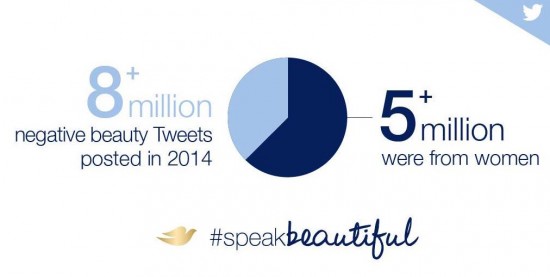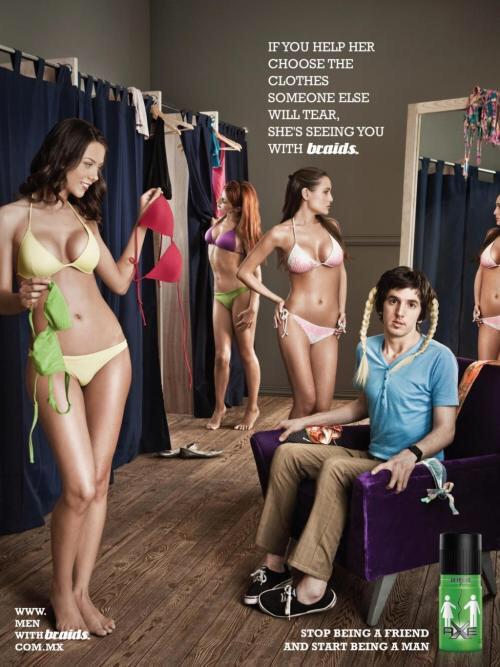Bad Chart Thursday: Dove’s #NewspeakBeautiful

I always knew that George Orwell was on to something. Sure, he was a little off on the year when it would all go down–1984 was more the year of the big hair band than Big Brother (not that this wasn’t equally terrifying in its own right).
And today’s Thought Police do not use Orwell’s Telescreens to monitor us for thought crimes. They use Twitter.
Part of Dove’s recently launched #SpeakBeautiful campaign involves monitoring women’s tweets for negative comments about their own appearances, then replying to these tweets with suggestions for more positive Party-approved language.
That’s right, ladies. Smile. BIG SOAP IS WATCHING YOU.
And of course, the propaganda Dove uses to support policing women’s opinions about our own bodies has the usual terrible charts.
All the positive thinking in the world is not going to make 8+ million less than 5+ million. A pie chart doesn’t make sense for this information in the first place since they are not two separate parts of the whole. One number is a subset of the other.
But the other major problem with this chart, the focus on demonizing women, is present throughout the campaign messaging. All these “negative beauty” tweets about women are coming primarily from women, not men, because women are such catty bitches, amirite? I wonder, though, when putting together their keywords to find these tweets, did they include “fuckable” and “rapeable” and other pretty obviously negative words used to describe women’s “beauty” and bodies? I mean, if we’re talking about negativity that actually harms women, it seems like “you’re too fat to be rapeable” might rank in there with “I hate my hair.”
But it gets even worse. Not only are most of the (narrowly defined) negative beauty tweets coming from women, they are coming from INSIDE THE HOUSE!
(You can tell the chart shows women by the skirts. You know, in case that wasn’t clear.)
Is Dove implying that it would be better if a larger percentage of tweets were focused on other women instead of ourselves? I don’t think so, but clearly this is supposed to be the next level of revelation. We not only tweet negative things about beauty, we tweet them about ourselves! Dove clearly thinks women being negative at all is the problem. That women are the problem. If you have any doubt that women are to blame, just remember how untrustworthy we are:
Patronizing, policing, and insulting women to get them to change their behavior–Dove’s campaign uses methods straight out of the pick-up artist’s playbook. This isn’t surprising considering, as many have pointed out, that Dove’s parent company, Unilever, also owns Axe, known for its sexist, rapey ads targeted at men, such as this gem.
But the Dove campaign isn’t ironic coming from the company that markets Axe in this way. There’s no doublethink here. The two companies are perfectly consistent in their messaging: policing gender roles, encouraging women to be positive and compliant and men to be aggressive, and defining women’s value solely based on our bodies. The “self-esteem” #SpeakBeautiful purports to be attempting to raise in women focuses on women’s appearance, our “beauty and body image,” as though our bodies were the only parts of us that were important to esteem. If only we viewed our bodies more positively, everything else would fall into place because our bodies are the most important part of who we are.
The Dove campaign is ironic in that it so completely embodies the societal view of women’s value and women’s bodies that is at the root of negative body image while claiming to be fighting against the problem. As with so many other issues women speak out about, the moment we speak negatively, it’s our speech that’s the problem, not what we’re speaking about. The reaction to a problem becomes the problem. The effect becomes the cause. 2 + 2 = 5.









Very good article and well explained. Particularly the double standard from the same company is very revealing.
Yes, it’s a crummy chart, because the 8 is the same color as the small part of the pie, but I think what they meant is that 8 million is the whole pie, and 5 million is the # from women.
I thought it was clear that the ‘pie’ was the 8 million and the 5 million was the section of the pie marked. Had to read it a couple of times to try and understand what apparently bad about the chart.
That said – I found highlighting the difference between the Axe and the Dove side of the advertising was illuminating.